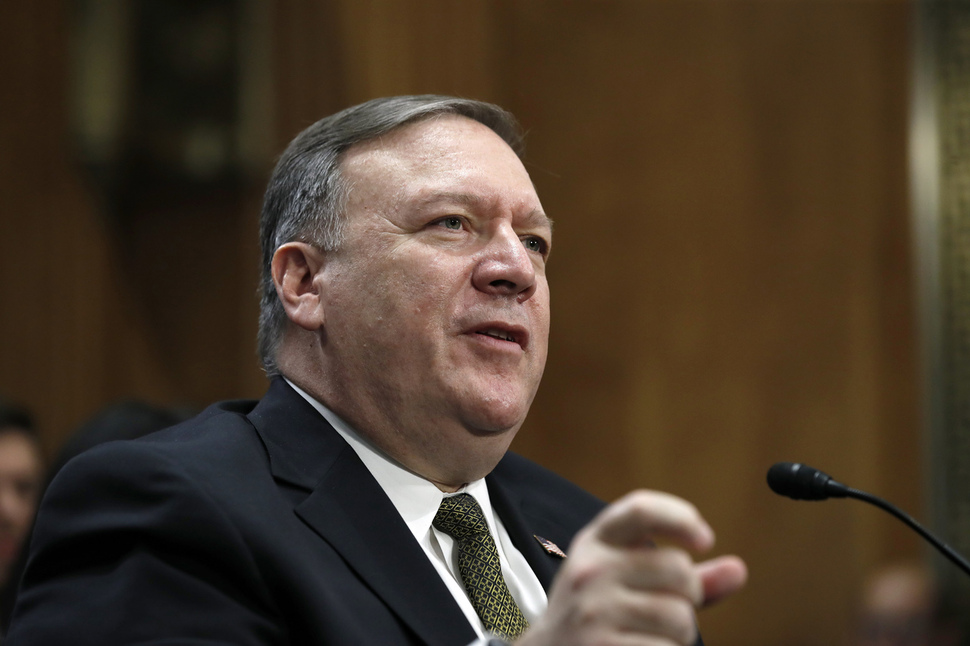 |
|
US Secretary of State nominee Mike Pompeo speaks during his confirmation hearing at the US Senate on Apr. 12. (AFP)
|
Pompeo’s Pyongyang visit likely meant to gauge Kim Jong-un’s willingness to denuclearize
US Central Intelligence Agency director and Secretary of State nominee Mike Pompeo’s top secret North Korea visit and meeting with leader Kim Jong-un is being seen as a symbolic illustration of the “top-down” speed tactics adopted in preparations for an upcoming North Korea-US summit. It is also expected to undercut calls for a postponement of the summit by some observers, who have claimed the lack of visible working-level meetings between the two sides suggests a shortage of preparations. Pompeo’s top secret visit may have been a practical inevitability in terms of meeting the tight deadline for the summit, which is reportedly to take place in late May or early June. “This summit is happening from zero, which means they have one to two months to prepare for things that normally take several months, including the agenda as well as the date, protocol, and security,” a senior South Korean government official said. This means the summit preparations cannot follow the typical procedures of going through successive working-level meetings at the bureau director, vice minister, and minister levels. Pompeo’s visit appears to have had multiple aims beyond meeting practical and technical needs. In terms of its timing, it occurred directly after a summit on Mar. 25–28 by Kim and Chinese President Xi Jinping. It could be seen as having had the goal of assessing the process and outcome of the North Korea-China summit, which took place in absolute secrecy. The primary aim appears to have been for Pompeo to meet with Kim as Trump’s special envoy and confirm directly North Korea’s commitment to denuclearizing. While Pyongyang’s “willingness” to denuclearize had been communicated through the Chinese government and members of a South Korean special envoy’s delegation that met with Kim, this would not have been enough to establish the political momentum needed within the US for the North Korea-US summit. In that sense, the visit by Pompeo, who is considered a close confidant of Trump’s, could be seen as the first example of indirect dialogue between the two leaders through “special envoy diplomacy.” On Apr. 8, roughly one week after Pompeo’s visit, US news outlets widely quoted senior officials as saying Kim had communicated his readiness to discuss the Korean Peninsula’s denuclearization at the North Korea-US summit – suggesting the visit achieved its desired aim. Pompeo also appears to have held in-depth discussions during his visit on Pyongyang’s demands as conditions for denuclearization, namely the removal of military threats and guarantees on its regime’s security. Multiple Washington sources familiar with the North Korea-US summit discussions told the Hankyoreh that Pyongyang had communicated a list of demands in the recent meetings, including the withdrawal of US strategic nuclear assets from South Korea, a halt to the deployment of strategic nuclear assets during joint military exercises with South Korea, guarantees against attacks with conventional or nuclear weapons, replacement of the armistice agreement with a peace agreement, and the establishment of diplomatic ties between North Korea and the US. The atmosphere in the US was generally positive. During his confirmation hearing before the Senate Foreign Relations Committee on Apr. 12, Pompeo stressed that “no one is under any illusions” that Trump and Kim’s summit will immediately lead to a comprehensive agreement. But it could “set out the conditions that would be acceptable to each side for the two leaders that will ultimately make the decision about whether such an agreement can be achieved and then set in place,” he added. Notably, Kim’s unusual direct mention of North Korea-US dialogue at a Workers’ Party Politburo meeting on Apr. 9 took place after the visit by Trump’s special envoy – hinting at Pyongyang’s confidence in Washington’s commitment to dialogue. It remains unconfirmed whether North Korea agreed to the “denuclearization deadline” of one to two years that the US has suggested to prevent it from using the talks as a stalling tactic. The two sides have so far also been unable to agree on the question of the summit’s venue. Also interesting is the fact that Trump disclosed the direct dialogue with Kim and inter-Korean discussions on an end to the Korean War in remarks prior to a summit with Japanese Prime Minister Shinzo Abe. Some analysts saw the remarks as intended as a check against Abe, who hopes to see the North Korea-US summit delayed. Others have suggested this was aimed at assisting Pompeo’s confirmation by the Senate by playing up his “outstanding diplomatic capabilities” in order to gain the support of Democratic senators. By Yi Yong-in, Washington correspondent, Kim Ji-eun and Noh Ji-won, staff reporters Please direct questions or comments to [english@hani.co.kr]






